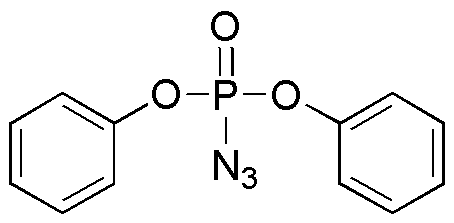Diphenyl phosphoryl azide is widely utilized in research focused on:
- Organic Synthesis: This compound serves as a key reagent in the synthesis of various organic molecules, particularly in the formation of azides, which are valuable intermediates in pharmaceuticals and agrochemicals.
- Pharmaceutical Development: It plays a crucial role in drug discovery, enabling the creation of new compounds with potential therapeutic effects, particularly in the development of anti-cancer agents.
- Material Science: The compound is used in the production of advanced materials, including polymers and coatings, enhancing properties such as durability and resistance to environmental factors.
- Explosive Research: Due to its azide group, it is studied for its potential in energetic materials, contributing to the development of safer and more efficient explosives.
- Bioconjugation: It is employed in bioconjugation techniques, allowing researchers to attach biomolecules to surfaces or other molecules, which is essential in diagnostics and therapeutic applications.
Información general
Propiedades
Seguridad y normativas
Aplicaciones
Diphenyl phosphoryl azide is widely utilized in research focused on:
- Organic Synthesis: This compound serves as a key reagent in the synthesis of various organic molecules, particularly in the formation of azides, which are valuable intermediates in pharmaceuticals and agrochemicals.
- Pharmaceutical Development: It plays a crucial role in drug discovery, enabling the creation of new compounds with potential therapeutic effects, particularly in the development of anti-cancer agents.
- Material Science: The compound is used in the production of advanced materials, including polymers and coatings, enhancing properties such as durability and resistance to environmental factors.
- Explosive Research: Due to its azide group, it is studied for its potential in energetic materials, contributing to the development of safer and more efficient explosives.
- Bioconjugation: It is employed in bioconjugation techniques, allowing researchers to attach biomolecules to surfaces or other molecules, which is essential in diagnostics and therapeutic applications.
Documentos
Hojas de datos de seguridad (HDS)
La SDS proporciona información de seguridad completa sobre la manipulación, el almacenamiento y la eliminación del producto.
Especificación del producto (PS)
La PS proporciona un desglose completo de las propiedades del producto, incluida la composición química, el estado físico, la pureza y los requisitos de almacenamiento. También detalla los rangos de calidad aceptables y las aplicaciones previstas del producto.
Certificados de análisis (COA)
Busque certificados de análisis (COA) ingresando el número de lote del producto. Los números de lote y de partida se pueden encontrar en la etiqueta de un producto después de las palabras "Lote" o "Lote".
Número de catálogo
Número de lote/lote
Certificados de origen (COO)
Este certificado de origen confirma el país en el que se fabricó el producto y también detalla los materiales y componentes utilizados en él y si se deriva de fuentes naturales, sintéticas u otras fuentes específicas. Este certificado puede ser necesario para cumplir con las normativas aduaneras, comerciales y regulatorias.
Número de catálogo
Número de lote/lote
Hojas de datos de seguridad (HDS)
La SDS proporciona información de seguridad completa sobre la manipulación, el almacenamiento y la eliminación del producto.
DownloadEspecificación del producto (PS)
La PS proporciona un desglose completo de las propiedades del producto, incluida la composición química, el estado físico, la pureza y los requisitos de almacenamiento. También detalla los rangos de calidad aceptables y las aplicaciones previstas del producto.
DownloadCertificados de análisis (COA)
Busque certificados de análisis (COA) ingresando el número de lote del producto. Los números de lote y de partida se pueden encontrar en la etiqueta de un producto después de las palabras "Lote" o "Lote".
Número de catálogo
Número de lote/lote
Certificados de origen (COO)
Este certificado de origen confirma el país en el que se fabricó el producto y también detalla los materiales y componentes utilizados en él y si se deriva de fuentes naturales, sintéticas u otras fuentes específicas. Este certificado puede ser necesario para cumplir con las normativas aduaneras, comerciales y regulatorias.


